Report on the Operation and Management Strategies of Leyland Trucks
VerifiedAdded on 2020/07/22
|12
|4003
|46
Report
AI Summary
This report provides a comprehensive analysis of the operation and management strategies employed by Leyland Trucks. It begins with an introduction outlining the company's background and operational context, followed by a detailed examination of operation management principles, including reality, organization, accountability, and variance. The report then delves into the application of Six Sigma methodologies, specifically the DMAIC cycle, to improve operational processes. Furthermore, the report explores continuous improvement plans, emphasizing promotional activities, after-sale services, and employee relations. The application of the product life cycle (PLC) is also analyzed, illustrating its stages and impact on the company's strategic decisions. The report concludes by summarizing the effectiveness of these strategies and their contribution to Leyland Trucks' overall performance and market position.
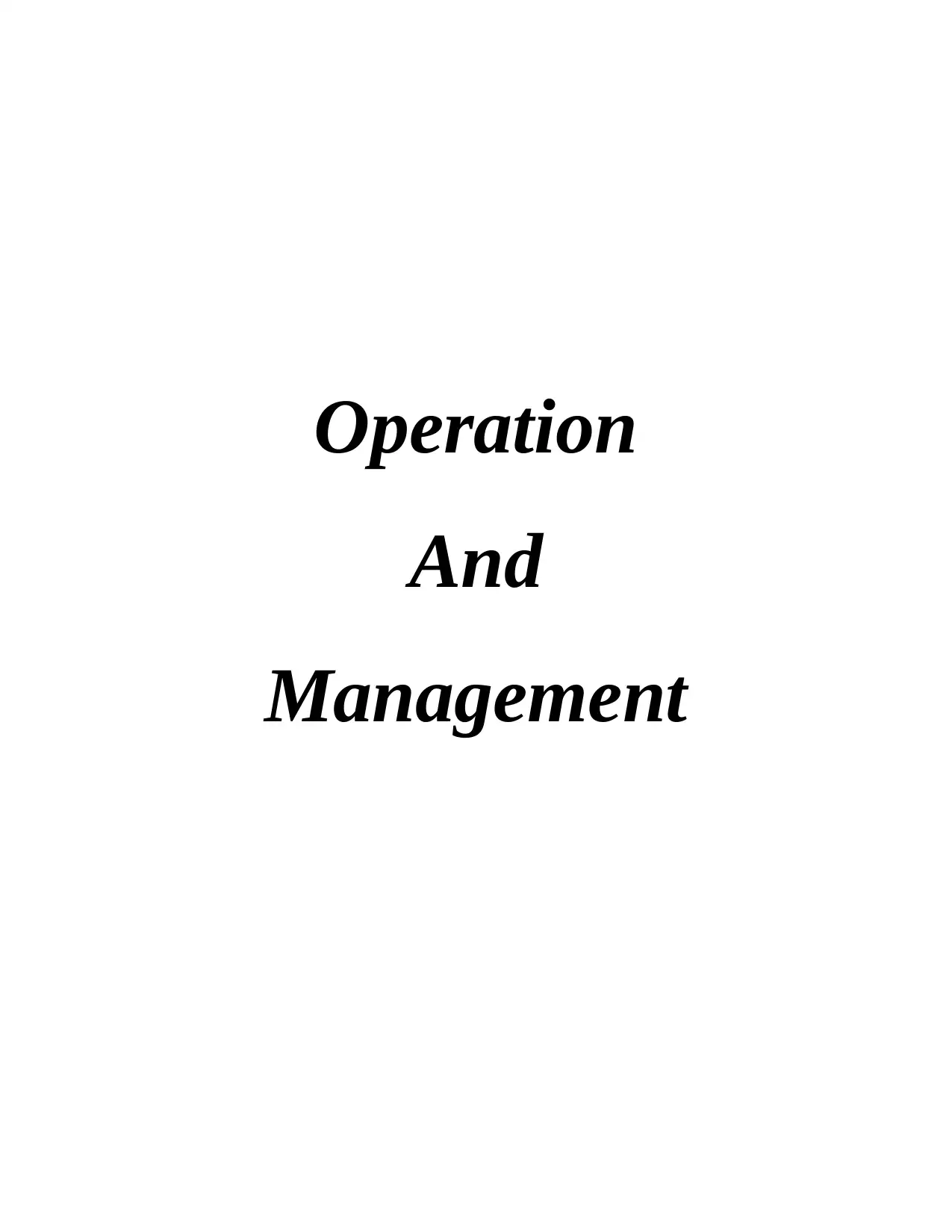
Operation
And
Management
And
Management
Paraphrase This Document
Need a fresh take? Get an instant paraphrase of this document with our AI Paraphraser
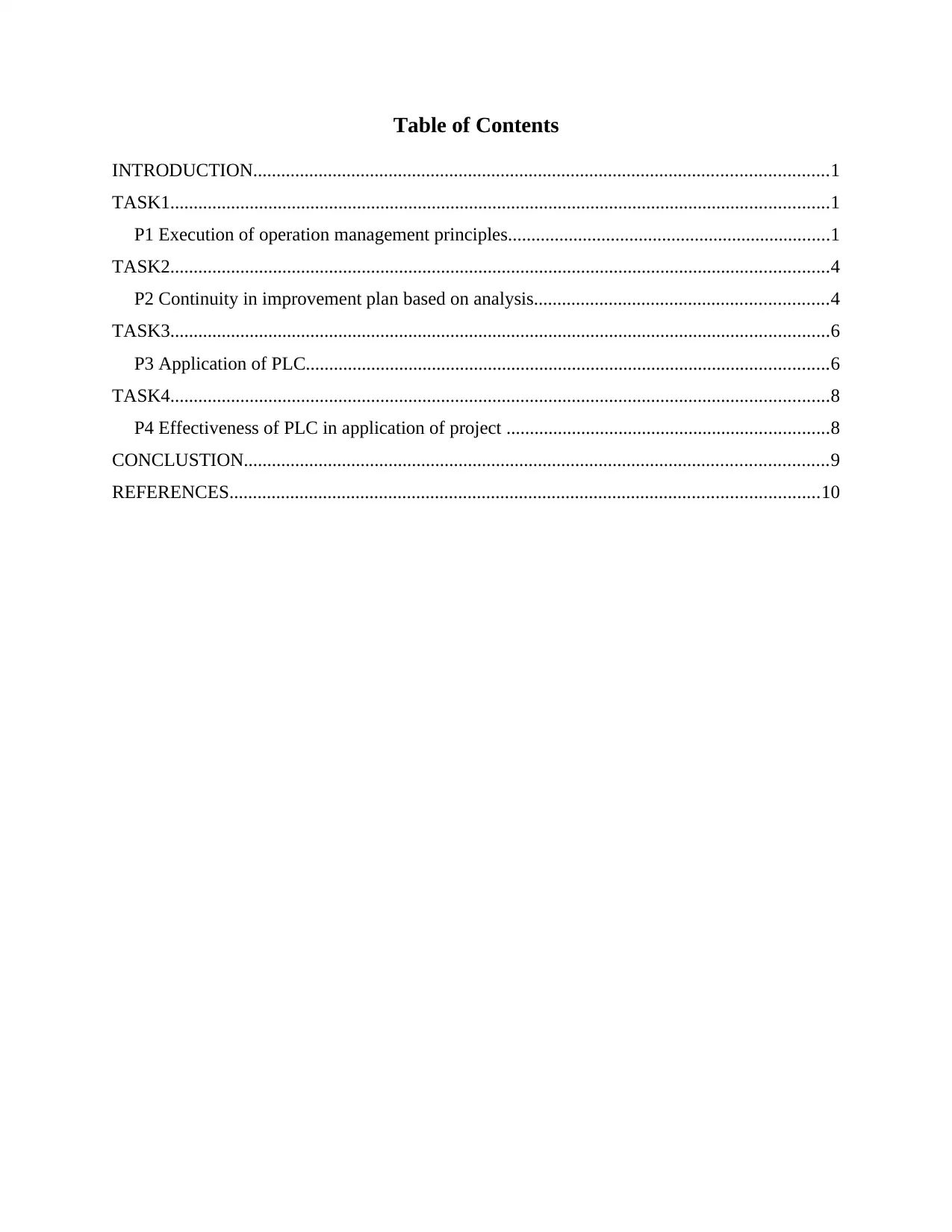
Table of Contents
INTRODUCTION...........................................................................................................................1
TASK1.............................................................................................................................................1
P1 Execution of operation management principles.....................................................................1
TASK2.............................................................................................................................................4
P2 Continuity in improvement plan based on analysis...............................................................4
TASK3.............................................................................................................................................6
P3 Application of PLC................................................................................................................6
TASK4.............................................................................................................................................8
P4 Effectiveness of PLC in application of project .....................................................................8
CONCLUSTION.............................................................................................................................9
REFERENCES..............................................................................................................................10
INTRODUCTION...........................................................................................................................1
TASK1.............................................................................................................................................1
P1 Execution of operation management principles.....................................................................1
TASK2.............................................................................................................................................4
P2 Continuity in improvement plan based on analysis...............................................................4
TASK3.............................................................................................................................................6
P3 Application of PLC................................................................................................................6
TASK4.............................................................................................................................................8
P4 Effectiveness of PLC in application of project .....................................................................8
CONCLUSTION.............................................................................................................................9
REFERENCES..............................................................................................................................10
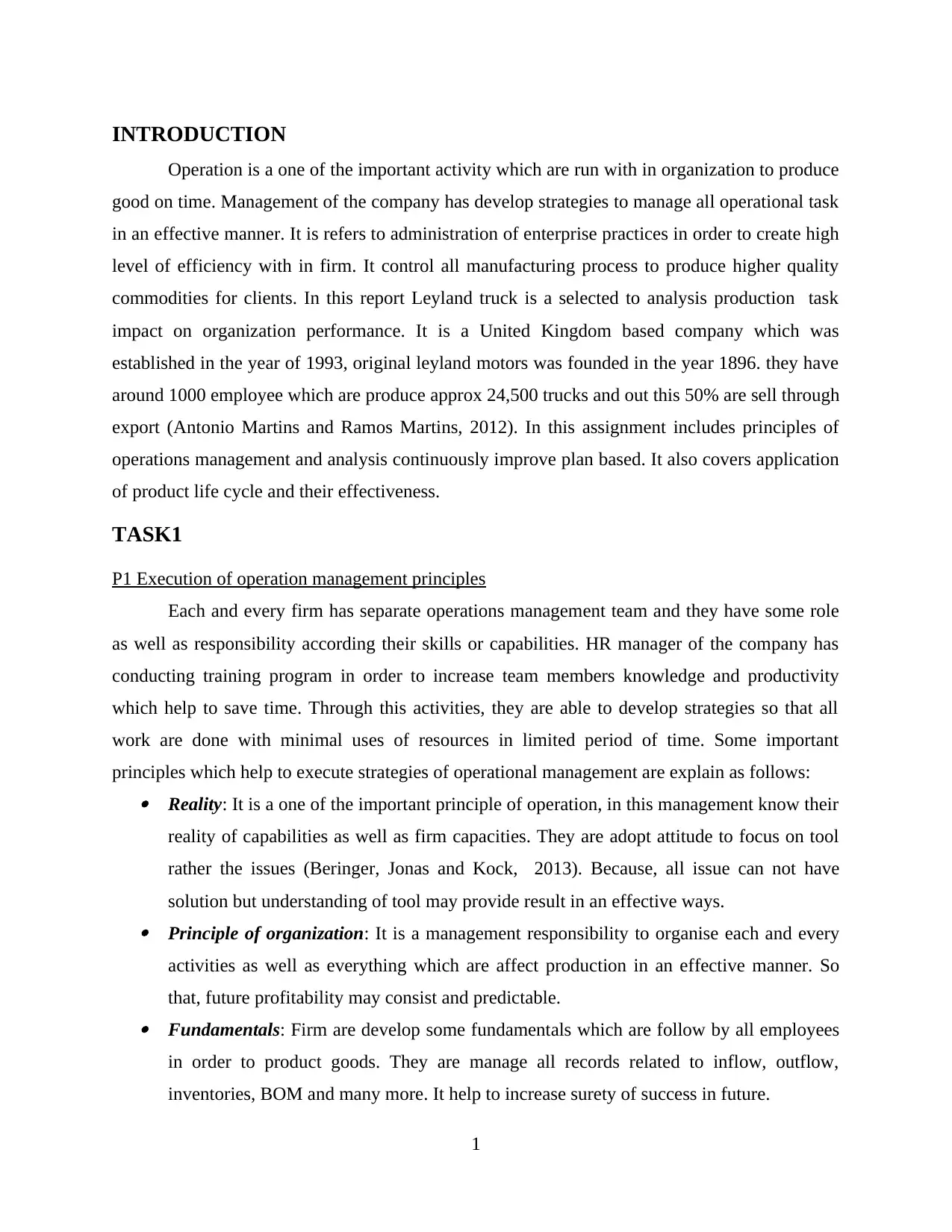
INTRODUCTION
Operation is a one of the important activity which are run with in organization to produce
good on time. Management of the company has develop strategies to manage all operational task
in an effective manner. It is refers to administration of enterprise practices in order to create high
level of efficiency with in firm. It control all manufacturing process to produce higher quality
commodities for clients. In this report Leyland truck is a selected to analysis production task
impact on organization performance. It is a United Kingdom based company which was
established in the year of 1993, original leyland motors was founded in the year 1896. they have
around 1000 employee which are produce approx 24,500 trucks and out this 50% are sell through
export (Antonio Martins and Ramos Martins, 2012). In this assignment includes principles of
operations management and analysis continuously improve plan based. It also covers application
of product life cycle and their effectiveness.
TASK1
P1 Execution of operation management principles
Each and every firm has separate operations management team and they have some role
as well as responsibility according their skills or capabilities. HR manager of the company has
conducting training program in order to increase team members knowledge and productivity
which help to save time. Through this activities, they are able to develop strategies so that all
work are done with minimal uses of resources in limited period of time. Some important
principles which help to execute strategies of operational management are explain as follows: Reality: It is a one of the important principle of operation, in this management know their
reality of capabilities as well as firm capacities. They are adopt attitude to focus on tool
rather the issues (Beringer, Jonas and Kock, 2013). Because, all issue can not have
solution but understanding of tool may provide result in an effective ways. Principle of organization: It is a management responsibility to organise each and every
activities as well as everything which are affect production in an effective manner. So
that, future profitability may consist and predictable. Fundamentals: Firm are develop some fundamentals which are follow by all employees
in order to product goods. They are manage all records related to inflow, outflow,
inventories, BOM and many more. It help to increase surety of success in future.
1
Operation is a one of the important activity which are run with in organization to produce
good on time. Management of the company has develop strategies to manage all operational task
in an effective manner. It is refers to administration of enterprise practices in order to create high
level of efficiency with in firm. It control all manufacturing process to produce higher quality
commodities for clients. In this report Leyland truck is a selected to analysis production task
impact on organization performance. It is a United Kingdom based company which was
established in the year of 1993, original leyland motors was founded in the year 1896. they have
around 1000 employee which are produce approx 24,500 trucks and out this 50% are sell through
export (Antonio Martins and Ramos Martins, 2012). In this assignment includes principles of
operations management and analysis continuously improve plan based. It also covers application
of product life cycle and their effectiveness.
TASK1
P1 Execution of operation management principles
Each and every firm has separate operations management team and they have some role
as well as responsibility according their skills or capabilities. HR manager of the company has
conducting training program in order to increase team members knowledge and productivity
which help to save time. Through this activities, they are able to develop strategies so that all
work are done with minimal uses of resources in limited period of time. Some important
principles which help to execute strategies of operational management are explain as follows: Reality: It is a one of the important principle of operation, in this management know their
reality of capabilities as well as firm capacities. They are adopt attitude to focus on tool
rather the issues (Beringer, Jonas and Kock, 2013). Because, all issue can not have
solution but understanding of tool may provide result in an effective ways. Principle of organization: It is a management responsibility to organise each and every
activities as well as everything which are affect production in an effective manner. So
that, future profitability may consist and predictable. Fundamentals: Firm are develop some fundamentals which are follow by all employees
in order to product goods. They are manage all records related to inflow, outflow,
inventories, BOM and many more. It help to increase surety of success in future.
1
⊘ This is a preview!⊘
Do you want full access?
Subscribe today to unlock all pages.

Trusted by 1+ million students worldwide
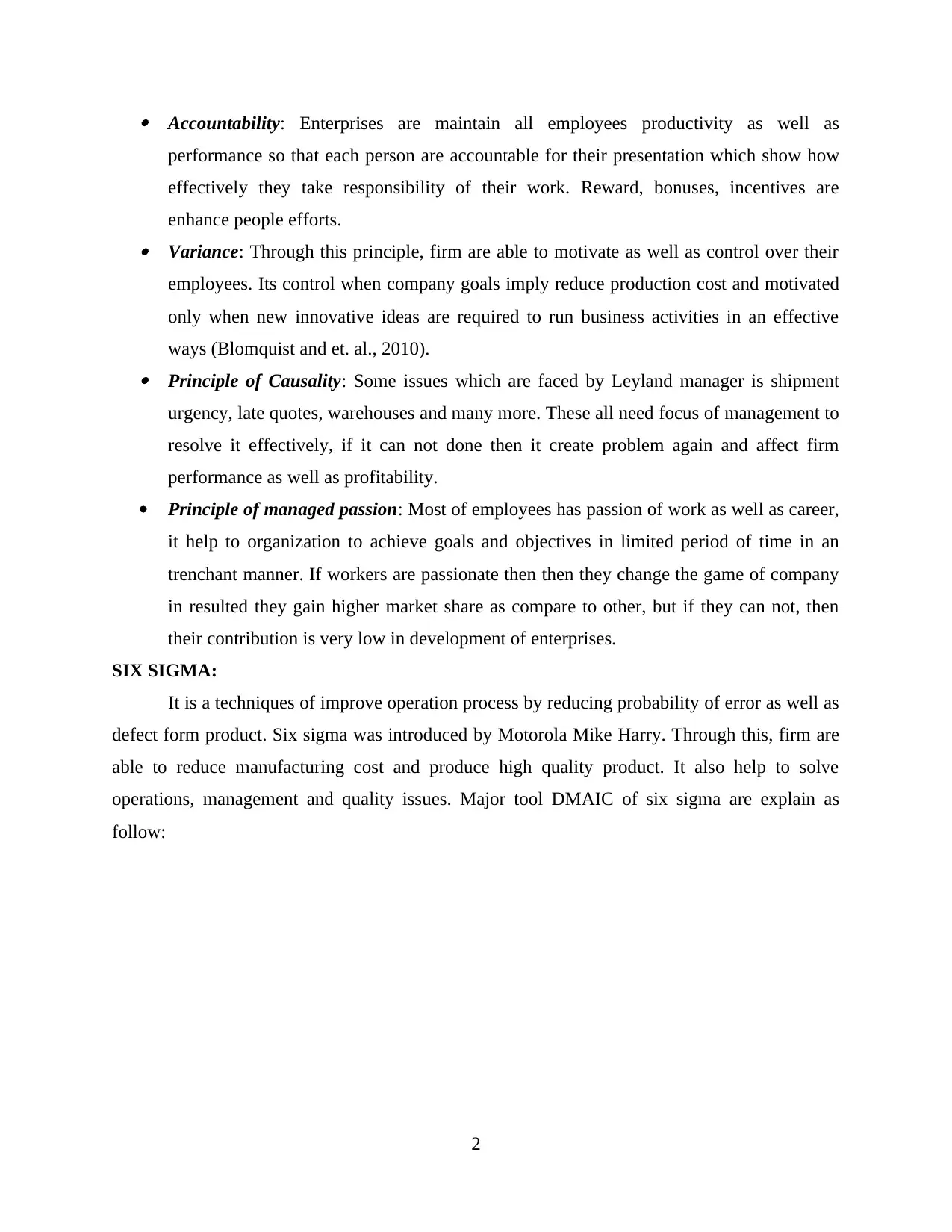
Accountability: Enterprises are maintain all employees productivity as well as
performance so that each person are accountable for their presentation which show how
effectively they take responsibility of their work. Reward, bonuses, incentives are
enhance people efforts. Variance: Through this principle, firm are able to motivate as well as control over their
employees. Its control when company goals imply reduce production cost and motivated
only when new innovative ideas are required to run business activities in an effective
ways (Blomquist and et. al., 2010). Principle of Causality: Some issues which are faced by Leyland manager is shipment
urgency, late quotes, warehouses and many more. These all need focus of management to
resolve it effectively, if it can not done then it create problem again and affect firm
performance as well as profitability.
Principle of managed passion: Most of employees has passion of work as well as career,
it help to organization to achieve goals and objectives in limited period of time in an
trenchant manner. If workers are passionate then then they change the game of company
in resulted they gain higher market share as compare to other, but if they can not, then
their contribution is very low in development of enterprises.
SIX SIGMA:
It is a techniques of improve operation process by reducing probability of error as well as
defect form product. Six sigma was introduced by Motorola Mike Harry. Through this, firm are
able to reduce manufacturing cost and produce high quality product. It also help to solve
operations, management and quality issues. Major tool DMAIC of six sigma are explain as
follow:
2
performance so that each person are accountable for their presentation which show how
effectively they take responsibility of their work. Reward, bonuses, incentives are
enhance people efforts. Variance: Through this principle, firm are able to motivate as well as control over their
employees. Its control when company goals imply reduce production cost and motivated
only when new innovative ideas are required to run business activities in an effective
ways (Blomquist and et. al., 2010). Principle of Causality: Some issues which are faced by Leyland manager is shipment
urgency, late quotes, warehouses and many more. These all need focus of management to
resolve it effectively, if it can not done then it create problem again and affect firm
performance as well as profitability.
Principle of managed passion: Most of employees has passion of work as well as career,
it help to organization to achieve goals and objectives in limited period of time in an
trenchant manner. If workers are passionate then then they change the game of company
in resulted they gain higher market share as compare to other, but if they can not, then
their contribution is very low in development of enterprises.
SIX SIGMA:
It is a techniques of improve operation process by reducing probability of error as well as
defect form product. Six sigma was introduced by Motorola Mike Harry. Through this, firm are
able to reduce manufacturing cost and produce high quality product. It also help to solve
operations, management and quality issues. Major tool DMAIC of six sigma are explain as
follow:
2
Paraphrase This Document
Need a fresh take? Get an instant paraphrase of this document with our AI Paraphraser
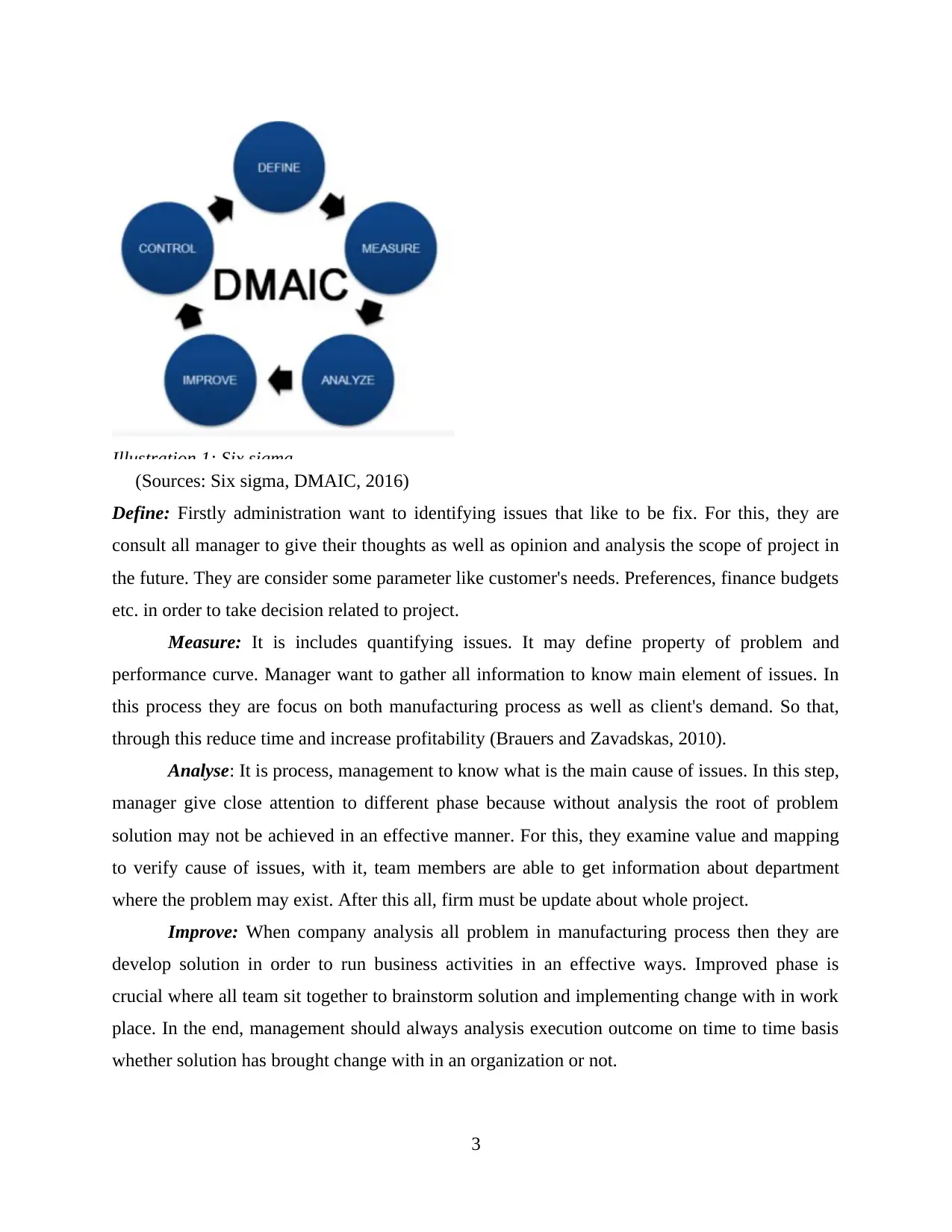
Illustration 1: Six sigma
(Sources: Six sigma, DMAIC, 2016)
Define: Firstly administration want to identifying issues that like to be fix. For this, they are
consult all manager to give their thoughts as well as opinion and analysis the scope of project in
the future. They are consider some parameter like customer's needs. Preferences, finance budgets
etc. in order to take decision related to project.
Measure: It is includes quantifying issues. It may define property of problem and
performance curve. Manager want to gather all information to know main element of issues. In
this process they are focus on both manufacturing process as well as client's demand. So that,
through this reduce time and increase profitability (Brauers and Zavadskas, 2010).
Analyse: It is process, management to know what is the main cause of issues. In this step,
manager give close attention to different phase because without analysis the root of problem
solution may not be achieved in an effective manner. For this, they examine value and mapping
to verify cause of issues, with it, team members are able to get information about department
where the problem may exist. After this all, firm must be update about whole project.
Improve: When company analysis all problem in manufacturing process then they are
develop solution in order to run business activities in an effective ways. Improved phase is
crucial where all team sit together to brainstorm solution and implementing change with in work
place. In the end, management should always analysis execution outcome on time to time basis
whether solution has brought change with in an organization or not.
3
(Sources: Six sigma, DMAIC, 2016)
Define: Firstly administration want to identifying issues that like to be fix. For this, they are
consult all manager to give their thoughts as well as opinion and analysis the scope of project in
the future. They are consider some parameter like customer's needs. Preferences, finance budgets
etc. in order to take decision related to project.
Measure: It is includes quantifying issues. It may define property of problem and
performance curve. Manager want to gather all information to know main element of issues. In
this process they are focus on both manufacturing process as well as client's demand. So that,
through this reduce time and increase profitability (Brauers and Zavadskas, 2010).
Analyse: It is process, management to know what is the main cause of issues. In this step,
manager give close attention to different phase because without analysis the root of problem
solution may not be achieved in an effective manner. For this, they examine value and mapping
to verify cause of issues, with it, team members are able to get information about department
where the problem may exist. After this all, firm must be update about whole project.
Improve: When company analysis all problem in manufacturing process then they are
develop solution in order to run business activities in an effective ways. Improved phase is
crucial where all team sit together to brainstorm solution and implementing change with in work
place. In the end, management should always analysis execution outcome on time to time basis
whether solution has brought change with in an organization or not.
3
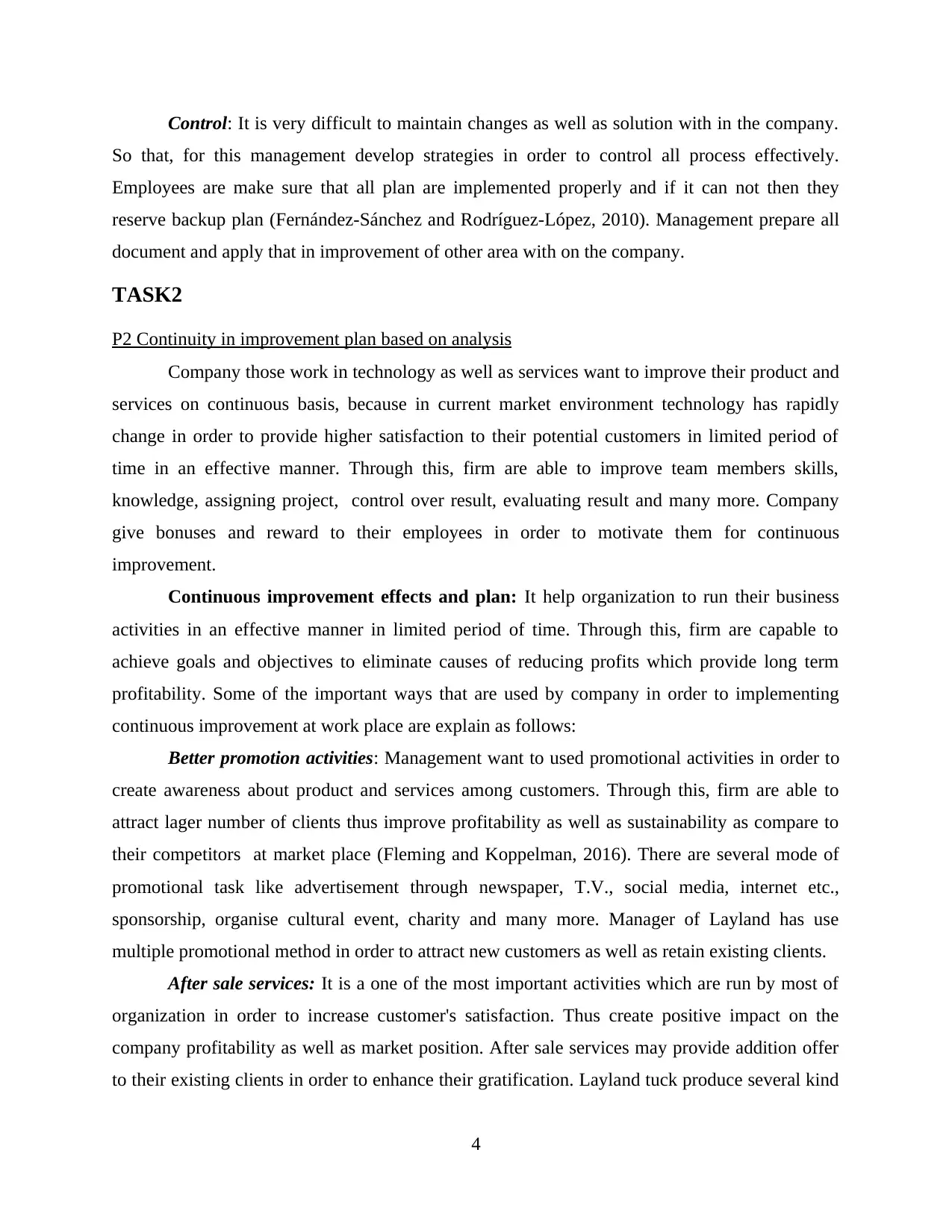
Control: It is very difficult to maintain changes as well as solution with in the company.
So that, for this management develop strategies in order to control all process effectively.
Employees are make sure that all plan are implemented properly and if it can not then they
reserve backup plan (Fernández-Sánchez and Rodríguez-López, 2010). Management prepare all
document and apply that in improvement of other area with on the company.
TASK2
P2 Continuity in improvement plan based on analysis
Company those work in technology as well as services want to improve their product and
services on continuous basis, because in current market environment technology has rapidly
change in order to provide higher satisfaction to their potential customers in limited period of
time in an effective manner. Through this, firm are able to improve team members skills,
knowledge, assigning project, control over result, evaluating result and many more. Company
give bonuses and reward to their employees in order to motivate them for continuous
improvement.
Continuous improvement effects and plan: It help organization to run their business
activities in an effective manner in limited period of time. Through this, firm are capable to
achieve goals and objectives to eliminate causes of reducing profits which provide long term
profitability. Some of the important ways that are used by company in order to implementing
continuous improvement at work place are explain as follows:
Better promotion activities: Management want to used promotional activities in order to
create awareness about product and services among customers. Through this, firm are able to
attract lager number of clients thus improve profitability as well as sustainability as compare to
their competitors at market place (Fleming and Koppelman, 2016). There are several mode of
promotional task like advertisement through newspaper, T.V., social media, internet etc.,
sponsorship, organise cultural event, charity and many more. Manager of Layland has use
multiple promotional method in order to attract new customers as well as retain existing clients.
After sale services: It is a one of the most important activities which are run by most of
organization in order to increase customer's satisfaction. Thus create positive impact on the
company profitability as well as market position. After sale services may provide addition offer
to their existing clients in order to enhance their gratification. Layland tuck produce several kind
4
So that, for this management develop strategies in order to control all process effectively.
Employees are make sure that all plan are implemented properly and if it can not then they
reserve backup plan (Fernández-Sánchez and Rodríguez-López, 2010). Management prepare all
document and apply that in improvement of other area with on the company.
TASK2
P2 Continuity in improvement plan based on analysis
Company those work in technology as well as services want to improve their product and
services on continuous basis, because in current market environment technology has rapidly
change in order to provide higher satisfaction to their potential customers in limited period of
time in an effective manner. Through this, firm are able to improve team members skills,
knowledge, assigning project, control over result, evaluating result and many more. Company
give bonuses and reward to their employees in order to motivate them for continuous
improvement.
Continuous improvement effects and plan: It help organization to run their business
activities in an effective manner in limited period of time. Through this, firm are capable to
achieve goals and objectives to eliminate causes of reducing profits which provide long term
profitability. Some of the important ways that are used by company in order to implementing
continuous improvement at work place are explain as follows:
Better promotion activities: Management want to used promotional activities in order to
create awareness about product and services among customers. Through this, firm are able to
attract lager number of clients thus improve profitability as well as sustainability as compare to
their competitors at market place (Fleming and Koppelman, 2016). There are several mode of
promotional task like advertisement through newspaper, T.V., social media, internet etc.,
sponsorship, organise cultural event, charity and many more. Manager of Layland has use
multiple promotional method in order to attract new customers as well as retain existing clients.
After sale services: It is a one of the most important activities which are run by most of
organization in order to increase customer's satisfaction. Thus create positive impact on the
company profitability as well as market position. After sale services may provide addition offer
to their existing clients in order to enhance their gratification. Layland tuck produce several kind
4
⊘ This is a preview!⊘
Do you want full access?
Subscribe today to unlock all pages.

Trusted by 1+ million students worldwide
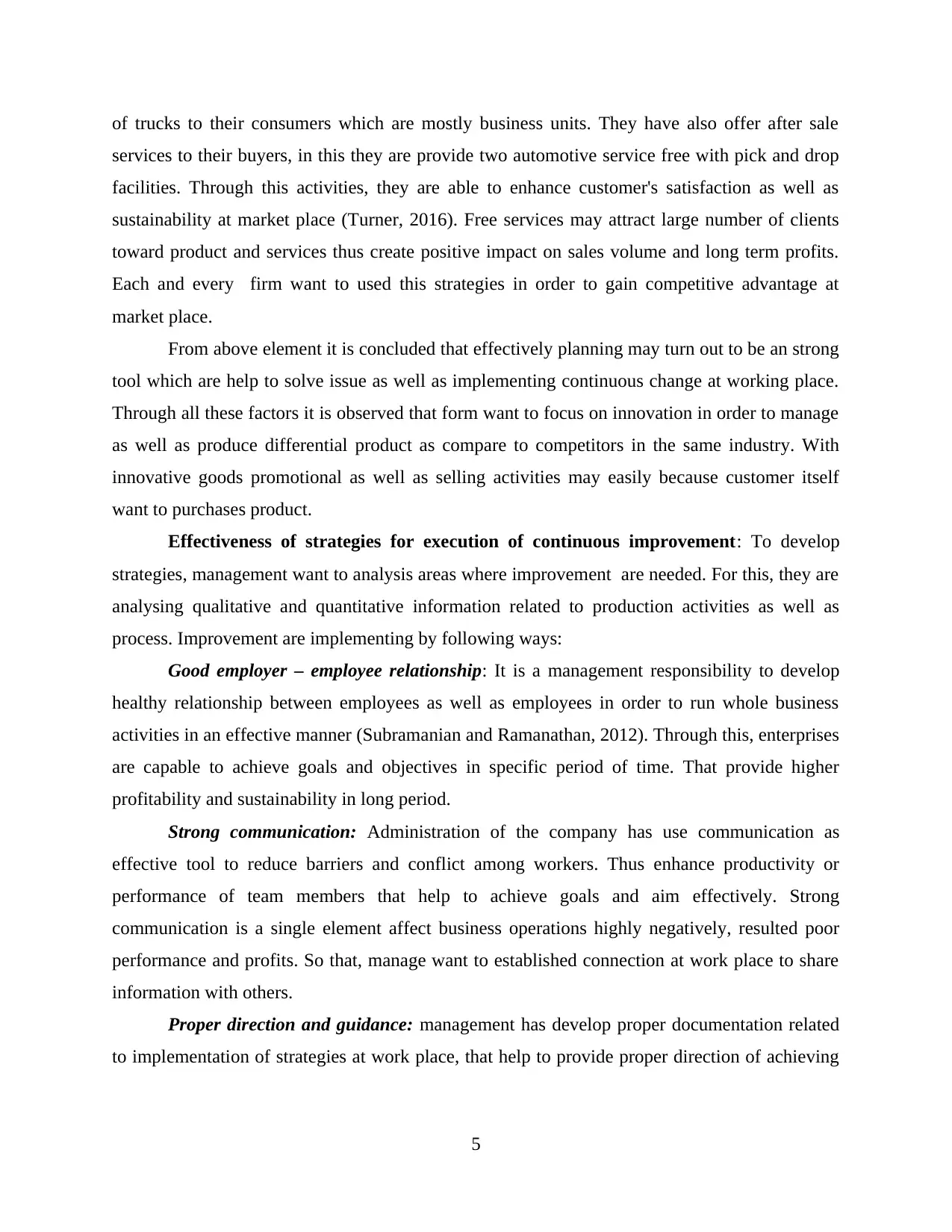
of trucks to their consumers which are mostly business units. They have also offer after sale
services to their buyers, in this they are provide two automotive service free with pick and drop
facilities. Through this activities, they are able to enhance customer's satisfaction as well as
sustainability at market place (Turner, 2016). Free services may attract large number of clients
toward product and services thus create positive impact on sales volume and long term profits.
Each and every firm want to used this strategies in order to gain competitive advantage at
market place.
From above element it is concluded that effectively planning may turn out to be an strong
tool which are help to solve issue as well as implementing continuous change at working place.
Through all these factors it is observed that form want to focus on innovation in order to manage
as well as produce differential product as compare to competitors in the same industry. With
innovative goods promotional as well as selling activities may easily because customer itself
want to purchases product.
Effectiveness of strategies for execution of continuous improvement: To develop
strategies, management want to analysis areas where improvement are needed. For this, they are
analysing qualitative and quantitative information related to production activities as well as
process. Improvement are implementing by following ways:
Good employer – employee relationship: It is a management responsibility to develop
healthy relationship between employees as well as employees in order to run whole business
activities in an effective manner (Subramanian and Ramanathan, 2012). Through this, enterprises
are capable to achieve goals and objectives in specific period of time. That provide higher
profitability and sustainability in long period.
Strong communication: Administration of the company has use communication as
effective tool to reduce barriers and conflict among workers. Thus enhance productivity or
performance of team members that help to achieve goals and aim effectively. Strong
communication is a single element affect business operations highly negatively, resulted poor
performance and profits. So that, manage want to established connection at work place to share
information with others.
Proper direction and guidance: management has develop proper documentation related
to implementation of strategies at work place, that help to provide proper direction of achieving
5
services to their buyers, in this they are provide two automotive service free with pick and drop
facilities. Through this activities, they are able to enhance customer's satisfaction as well as
sustainability at market place (Turner, 2016). Free services may attract large number of clients
toward product and services thus create positive impact on sales volume and long term profits.
Each and every firm want to used this strategies in order to gain competitive advantage at
market place.
From above element it is concluded that effectively planning may turn out to be an strong
tool which are help to solve issue as well as implementing continuous change at working place.
Through all these factors it is observed that form want to focus on innovation in order to manage
as well as produce differential product as compare to competitors in the same industry. With
innovative goods promotional as well as selling activities may easily because customer itself
want to purchases product.
Effectiveness of strategies for execution of continuous improvement: To develop
strategies, management want to analysis areas where improvement are needed. For this, they are
analysing qualitative and quantitative information related to production activities as well as
process. Improvement are implementing by following ways:
Good employer – employee relationship: It is a management responsibility to develop
healthy relationship between employees as well as employees in order to run whole business
activities in an effective manner (Subramanian and Ramanathan, 2012). Through this, enterprises
are capable to achieve goals and objectives in specific period of time. That provide higher
profitability and sustainability in long period.
Strong communication: Administration of the company has use communication as
effective tool to reduce barriers and conflict among workers. Thus enhance productivity or
performance of team members that help to achieve goals and aim effectively. Strong
communication is a single element affect business operations highly negatively, resulted poor
performance and profits. So that, manage want to established connection at work place to share
information with others.
Proper direction and guidance: management has develop proper documentation related
to implementation of strategies at work place, that help to provide proper direction of achieving
5
Paraphrase This Document
Need a fresh take? Get an instant paraphrase of this document with our AI Paraphraser
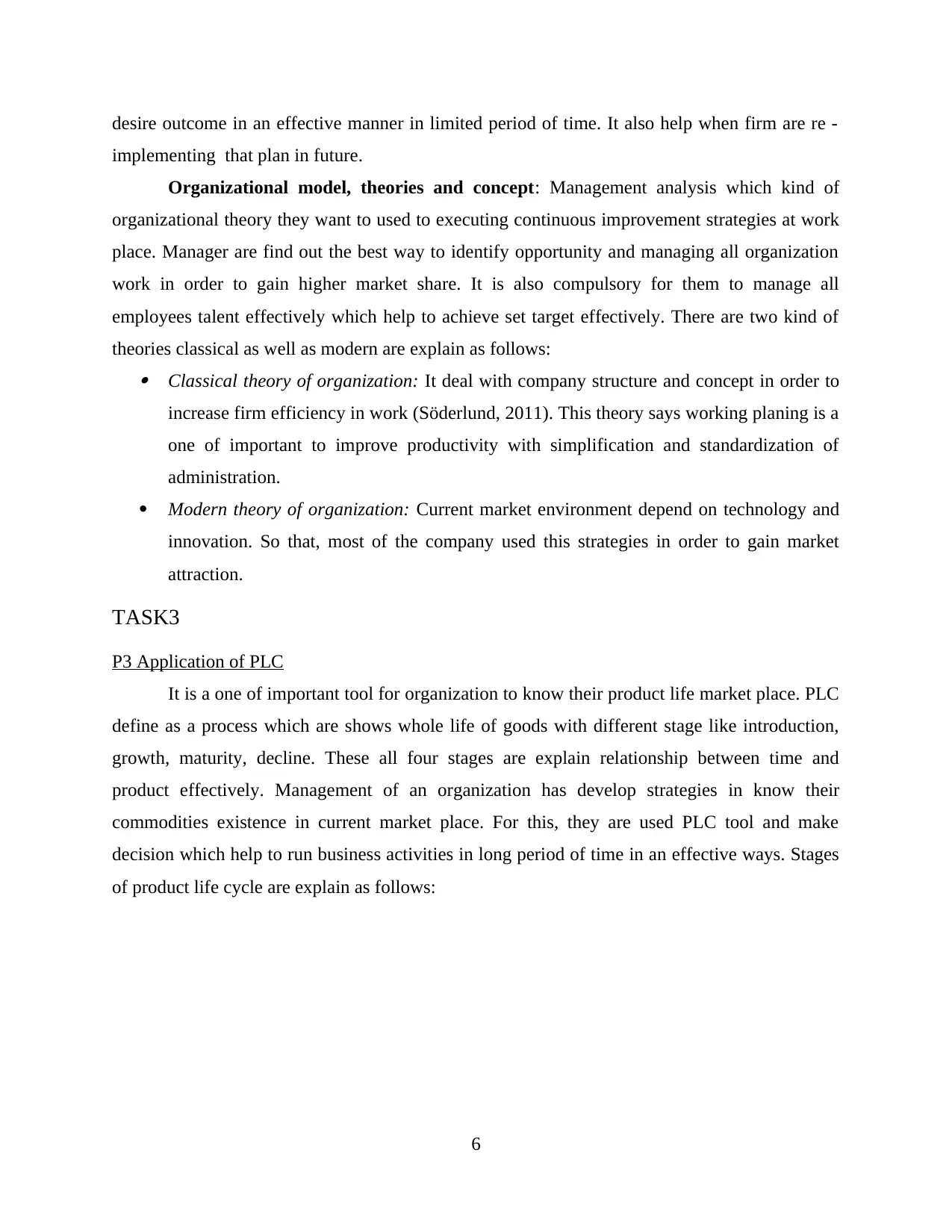
desire outcome in an effective manner in limited period of time. It also help when firm are re -
implementing that plan in future.
Organizational model, theories and concept: Management analysis which kind of
organizational theory they want to used to executing continuous improvement strategies at work
place. Manager are find out the best way to identify opportunity and managing all organization
work in order to gain higher market share. It is also compulsory for them to manage all
employees talent effectively which help to achieve set target effectively. There are two kind of
theories classical as well as modern are explain as follows: Classical theory of organization: It deal with company structure and concept in order to
increase firm efficiency in work (Söderlund, 2011). This theory says working planing is a
one of important to improve productivity with simplification and standardization of
administration.
Modern theory of organization: Current market environment depend on technology and
innovation. So that, most of the company used this strategies in order to gain market
attraction.
TASK3
P3 Application of PLC
It is a one of important tool for organization to know their product life market place. PLC
define as a process which are shows whole life of goods with different stage like introduction,
growth, maturity, decline. These all four stages are explain relationship between time and
product effectively. Management of an organization has develop strategies in know their
commodities existence in current market place. For this, they are used PLC tool and make
decision which help to run business activities in long period of time in an effective ways. Stages
of product life cycle are explain as follows:
6
implementing that plan in future.
Organizational model, theories and concept: Management analysis which kind of
organizational theory they want to used to executing continuous improvement strategies at work
place. Manager are find out the best way to identify opportunity and managing all organization
work in order to gain higher market share. It is also compulsory for them to manage all
employees talent effectively which help to achieve set target effectively. There are two kind of
theories classical as well as modern are explain as follows: Classical theory of organization: It deal with company structure and concept in order to
increase firm efficiency in work (Söderlund, 2011). This theory says working planing is a
one of important to improve productivity with simplification and standardization of
administration.
Modern theory of organization: Current market environment depend on technology and
innovation. So that, most of the company used this strategies in order to gain market
attraction.
TASK3
P3 Application of PLC
It is a one of important tool for organization to know their product life market place. PLC
define as a process which are shows whole life of goods with different stage like introduction,
growth, maturity, decline. These all four stages are explain relationship between time and
product effectively. Management of an organization has develop strategies in know their
commodities existence in current market place. For this, they are used PLC tool and make
decision which help to run business activities in long period of time in an effective ways. Stages
of product life cycle are explain as follows:
6

(Sources: Product life cycle, 2012)
Introduction: In this stage firm are develop new product and services and sale them at
market. It is a came into market at first time. But some international companies are expand their
business operations at other location which are new for them. In that area, old product that are
produce and sell in past are new for current time in another location. For example, Leyland sell
their truck at global level and continuously find of new location for sale goods in order to gain
advantage of introduction phase in that new location (Robichaud and Anantatmula, 2010). This
stage help firm to attract large numbers of customers toward their commodities and services. In
this stage, management of enterprises has develop promotional plan to create awareness related
to commodities feature, information, quality etc. among customers. For this, they also used
advertisement as a promotional tool.
Growth: In this stage clients are already aware about product as well as its substitute and
take purchase decision accordion to their needs and wants. In this stage, firm are continuously
increase their selling effort in order to gain higher market share. For this, they are change
promotion strategies of product on time to time basis to attract large number of clients. Thus
help to provide high profitability as well as long rum sustainability in same industry. In this
stage, firm want to spend money in advertisement and promotion activities to provide
information of product and difference with its substitute which help customers to take purchase
decision in an effective manner. For example, layland has used used various action of plan in
order to sell product at international level. They are develop strategies to attract customers that
are related to different social cultural environment.
7
Illustration 2: PLC
Introduction: In this stage firm are develop new product and services and sale them at
market. It is a came into market at first time. But some international companies are expand their
business operations at other location which are new for them. In that area, old product that are
produce and sell in past are new for current time in another location. For example, Leyland sell
their truck at global level and continuously find of new location for sale goods in order to gain
advantage of introduction phase in that new location (Robichaud and Anantatmula, 2010). This
stage help firm to attract large numbers of customers toward their commodities and services. In
this stage, management of enterprises has develop promotional plan to create awareness related
to commodities feature, information, quality etc. among customers. For this, they also used
advertisement as a promotional tool.
Growth: In this stage clients are already aware about product as well as its substitute and
take purchase decision accordion to their needs and wants. In this stage, firm are continuously
increase their selling effort in order to gain higher market share. For this, they are change
promotion strategies of product on time to time basis to attract large number of clients. Thus
help to provide high profitability as well as long rum sustainability in same industry. In this
stage, firm want to spend money in advertisement and promotion activities to provide
information of product and difference with its substitute which help customers to take purchase
decision in an effective manner. For example, layland has used used various action of plan in
order to sell product at international level. They are develop strategies to attract customers that
are related to different social cultural environment.
7
Illustration 2: PLC
⊘ This is a preview!⊘
Do you want full access?
Subscribe today to unlock all pages.

Trusted by 1+ million students worldwide
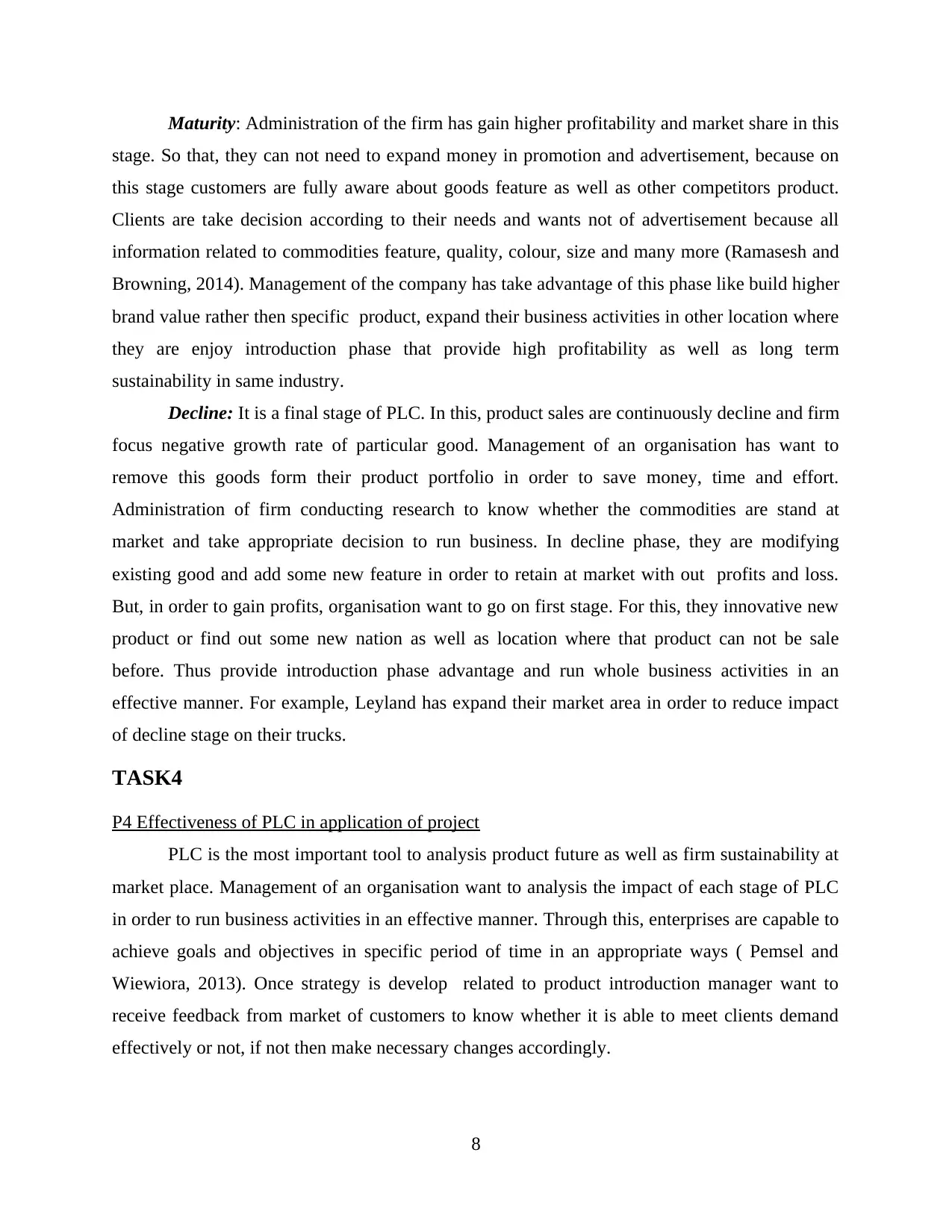
Maturity: Administration of the firm has gain higher profitability and market share in this
stage. So that, they can not need to expand money in promotion and advertisement, because on
this stage customers are fully aware about goods feature as well as other competitors product.
Clients are take decision according to their needs and wants not of advertisement because all
information related to commodities feature, quality, colour, size and many more (Ramasesh and
Browning, 2014). Management of the company has take advantage of this phase like build higher
brand value rather then specific product, expand their business activities in other location where
they are enjoy introduction phase that provide high profitability as well as long term
sustainability in same industry.
Decline: It is a final stage of PLC. In this, product sales are continuously decline and firm
focus negative growth rate of particular good. Management of an organisation has want to
remove this goods form their product portfolio in order to save money, time and effort.
Administration of firm conducting research to know whether the commodities are stand at
market and take appropriate decision to run business. In decline phase, they are modifying
existing good and add some new feature in order to retain at market with out profits and loss.
But, in order to gain profits, organisation want to go on first stage. For this, they innovative new
product or find out some new nation as well as location where that product can not be sale
before. Thus provide introduction phase advantage and run whole business activities in an
effective manner. For example, Leyland has expand their market area in order to reduce impact
of decline stage on their trucks.
TASK4
P4 Effectiveness of PLC in application of project
PLC is the most important tool to analysis product future as well as firm sustainability at
market place. Management of an organisation want to analysis the impact of each stage of PLC
in order to run business activities in an effective manner. Through this, enterprises are capable to
achieve goals and objectives in specific period of time in an appropriate ways ( Pemsel and
Wiewiora, 2013). Once strategy is develop related to product introduction manager want to
receive feedback from market of customers to know whether it is able to meet clients demand
effectively or not, if not then make necessary changes accordingly.
8
stage. So that, they can not need to expand money in promotion and advertisement, because on
this stage customers are fully aware about goods feature as well as other competitors product.
Clients are take decision according to their needs and wants not of advertisement because all
information related to commodities feature, quality, colour, size and many more (Ramasesh and
Browning, 2014). Management of the company has take advantage of this phase like build higher
brand value rather then specific product, expand their business activities in other location where
they are enjoy introduction phase that provide high profitability as well as long term
sustainability in same industry.
Decline: It is a final stage of PLC. In this, product sales are continuously decline and firm
focus negative growth rate of particular good. Management of an organisation has want to
remove this goods form their product portfolio in order to save money, time and effort.
Administration of firm conducting research to know whether the commodities are stand at
market and take appropriate decision to run business. In decline phase, they are modifying
existing good and add some new feature in order to retain at market with out profits and loss.
But, in order to gain profits, organisation want to go on first stage. For this, they innovative new
product or find out some new nation as well as location where that product can not be sale
before. Thus provide introduction phase advantage and run whole business activities in an
effective manner. For example, Leyland has expand their market area in order to reduce impact
of decline stage on their trucks.
TASK4
P4 Effectiveness of PLC in application of project
PLC is the most important tool to analysis product future as well as firm sustainability at
market place. Management of an organisation want to analysis the impact of each stage of PLC
in order to run business activities in an effective manner. Through this, enterprises are capable to
achieve goals and objectives in specific period of time in an appropriate ways ( Pemsel and
Wiewiora, 2013). Once strategy is develop related to product introduction manager want to
receive feedback from market of customers to know whether it is able to meet clients demand
effectively or not, if not then make necessary changes accordingly.
8
Paraphrase This Document
Need a fresh take? Get an instant paraphrase of this document with our AI Paraphraser

So that it help to gain high profits as well as sustainability at market place. Thus create
positive impact on customer, they think company are loyal toward their buyers are doing
continuous modification in exiting product which are able to full fill clients needs in an
appropriate manner in limited period of time. Thus provide higher brand value as well as equality
which help to attract new investors and expand their business in another nations. It is a mots
important factor of organisation in implementing PLC strategies at their production unit to
manufacturing product according to needs, preferences, demand, perceptions, attitude,
motivation factors and many more. Through this, company are able meet consumers requirement
in an effective ways (Mir and Pinnington, 2014).
Leyland is manufacturing commercial truck are sell them by both ways business to
business as well as business to consumers. PLC help them to provide information related to
product modification and market expansion. Their truck called DAF LF is introduced in the year
of 2001 and it sale in present market environment, because management of Leyland can not rise
decline stage by continuously modifying product as well as expand market in achieve
introduction phase. Management of an organisation used innovation strategies to upgrade
existing good, for example in the year of 2010, DFA introduced hybrid version which are called
LF45 at IAA2010 in Hannover. Leyland manufacturing truck for right hand person called DFA
CF,65, 75, 85 in 1992. All CF65 2 axle help right hand drivers to run their product in an
effective ways (Lenfle and Loch, 2010). Thus build positive brand image of the company in
customer's mind. One of the other effective example are, Management of Leyland produce DAF
XF when they are on maturity stage , in this product they are used high technology like 12.9 litre
engine with both automatic as well as manual formates. Thus provide advantage of introduction
of innovation or new or latest technology in trucks.
CONCLUSTION
From the above report it is concluded that operation and management is a one of the
important part of business unit. Through this task firm are able to convert raw material as well as
workers into product and services as expeditiously as possible to increase profitability of an
organization in long period of time. Company has continuously improve their product and
services in order to full fill customer's needs and wants in an effective ways. Six sigma strategies
help to reduce issue which are rise during production process and save time, money of the firm.
Leyland manufacture and modify existing trucks to cut down impact of decline stage.
9
positive impact on customer, they think company are loyal toward their buyers are doing
continuous modification in exiting product which are able to full fill clients needs in an
appropriate manner in limited period of time. Thus provide higher brand value as well as equality
which help to attract new investors and expand their business in another nations. It is a mots
important factor of organisation in implementing PLC strategies at their production unit to
manufacturing product according to needs, preferences, demand, perceptions, attitude,
motivation factors and many more. Through this, company are able meet consumers requirement
in an effective ways (Mir and Pinnington, 2014).
Leyland is manufacturing commercial truck are sell them by both ways business to
business as well as business to consumers. PLC help them to provide information related to
product modification and market expansion. Their truck called DAF LF is introduced in the year
of 2001 and it sale in present market environment, because management of Leyland can not rise
decline stage by continuously modifying product as well as expand market in achieve
introduction phase. Management of an organisation used innovation strategies to upgrade
existing good, for example in the year of 2010, DFA introduced hybrid version which are called
LF45 at IAA2010 in Hannover. Leyland manufacturing truck for right hand person called DFA
CF,65, 75, 85 in 1992. All CF65 2 axle help right hand drivers to run their product in an
effective ways (Lenfle and Loch, 2010). Thus build positive brand image of the company in
customer's mind. One of the other effective example are, Management of Leyland produce DAF
XF when they are on maturity stage , in this product they are used high technology like 12.9 litre
engine with both automatic as well as manual formates. Thus provide advantage of introduction
of innovation or new or latest technology in trucks.
CONCLUSTION
From the above report it is concluded that operation and management is a one of the
important part of business unit. Through this task firm are able to convert raw material as well as
workers into product and services as expeditiously as possible to increase profitability of an
organization in long period of time. Company has continuously improve their product and
services in order to full fill customer's needs and wants in an effective ways. Six sigma strategies
help to reduce issue which are rise during production process and save time, money of the firm.
Leyland manufacture and modify existing trucks to cut down impact of decline stage.
9
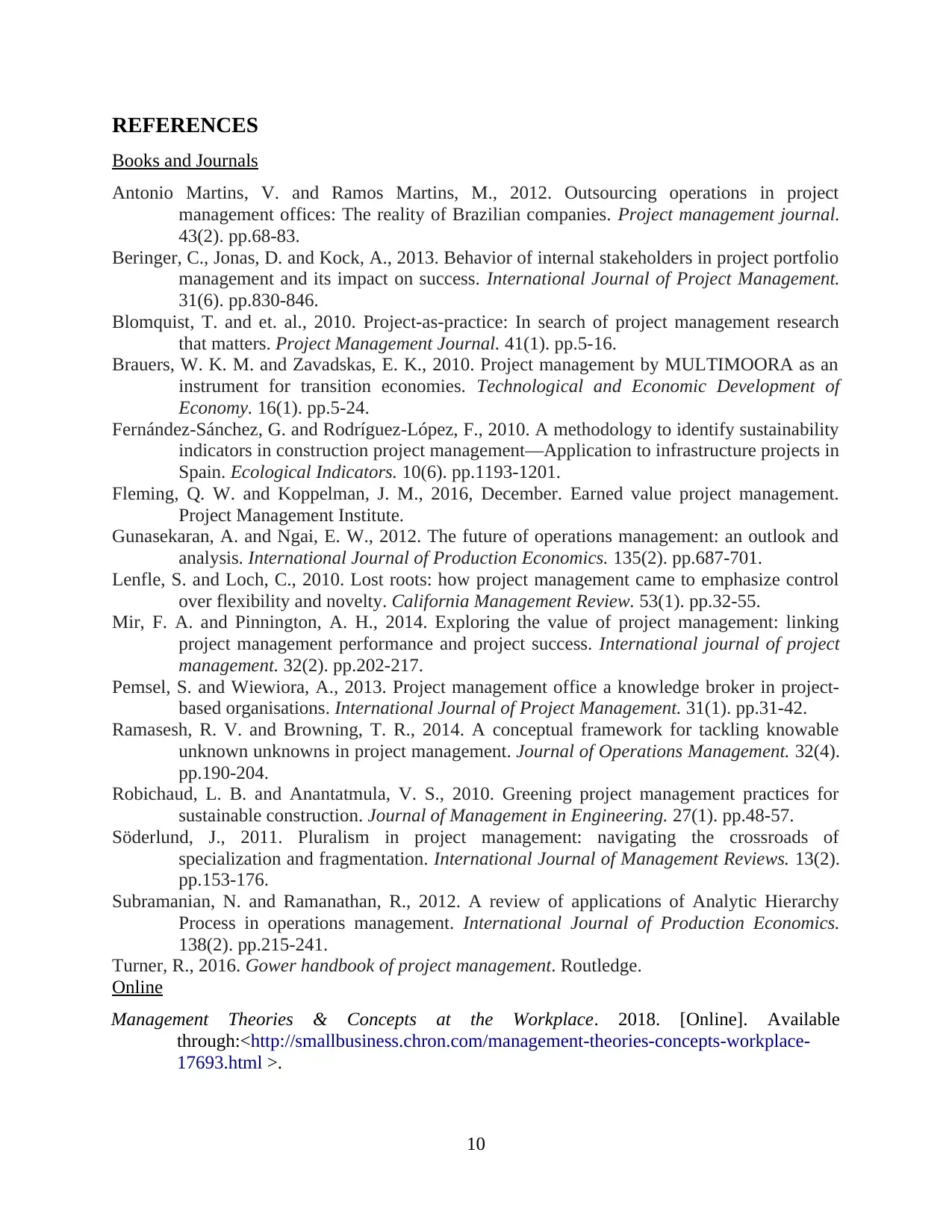
REFERENCES
Books and Journals
Antonio Martins, V. and Ramos Martins, M., 2012. Outsourcing operations in project
management offices: The reality of Brazilian companies. Project management journal.
43(2). pp.68-83.
Beringer, C., Jonas, D. and Kock, A., 2013. Behavior of internal stakeholders in project portfolio
management and its impact on success. International Journal of Project Management.
31(6). pp.830-846.
Blomquist, T. and et. al., 2010. Project‐as‐practice: In search of project management research
that matters. Project Management Journal. 41(1). pp.5-16.
Brauers, W. K. M. and Zavadskas, E. K., 2010. Project management by MULTIMOORA as an
instrument for transition economies. Technological and Economic Development of
Economy. 16(1). pp.5-24.
Fernández-Sánchez, G. and Rodríguez-López, F., 2010. A methodology to identify sustainability
indicators in construction project management—Application to infrastructure projects in
Spain. Ecological Indicators. 10(6). pp.1193-1201.
Fleming, Q. W. and Koppelman, J. M., 2016, December. Earned value project management.
Project Management Institute.
Gunasekaran, A. and Ngai, E. W., 2012. The future of operations management: an outlook and
analysis. International Journal of Production Economics. 135(2). pp.687-701.
Lenfle, S. and Loch, C., 2010. Lost roots: how project management came to emphasize control
over flexibility and novelty. California Management Review. 53(1). pp.32-55.
Mir, F. A. and Pinnington, A. H., 2014. Exploring the value of project management: linking
project management performance and project success. International journal of project
management. 32(2). pp.202-217.
Pemsel, S. and Wiewiora, A., 2013. Project management office a knowledge broker in project-
based organisations. International Journal of Project Management. 31(1). pp.31-42.
Ramasesh, R. V. and Browning, T. R., 2014. A conceptual framework for tackling knowable
unknown unknowns in project management. Journal of Operations Management. 32(4).
pp.190-204.
Robichaud, L. B. and Anantatmula, V. S., 2010. Greening project management practices for
sustainable construction. Journal of Management in Engineering. 27(1). pp.48-57.
Söderlund, J., 2011. Pluralism in project management: navigating the crossroads of
specialization and fragmentation. International Journal of Management Reviews. 13(2).
pp.153-176.
Subramanian, N. and Ramanathan, R., 2012. A review of applications of Analytic Hierarchy
Process in operations management. International Journal of Production Economics.
138(2). pp.215-241.
Turner, R., 2016. Gower handbook of project management. Routledge.
Online
Management Theories & Concepts at the Workplace. 2018. [Online]. Available
through:<http://smallbusiness.chron.com/management-theories-concepts-workplace-
17693.html >.
10
Books and Journals
Antonio Martins, V. and Ramos Martins, M., 2012. Outsourcing operations in project
management offices: The reality of Brazilian companies. Project management journal.
43(2). pp.68-83.
Beringer, C., Jonas, D. and Kock, A., 2013. Behavior of internal stakeholders in project portfolio
management and its impact on success. International Journal of Project Management.
31(6). pp.830-846.
Blomquist, T. and et. al., 2010. Project‐as‐practice: In search of project management research
that matters. Project Management Journal. 41(1). pp.5-16.
Brauers, W. K. M. and Zavadskas, E. K., 2010. Project management by MULTIMOORA as an
instrument for transition economies. Technological and Economic Development of
Economy. 16(1). pp.5-24.
Fernández-Sánchez, G. and Rodríguez-López, F., 2010. A methodology to identify sustainability
indicators in construction project management—Application to infrastructure projects in
Spain. Ecological Indicators. 10(6). pp.1193-1201.
Fleming, Q. W. and Koppelman, J. M., 2016, December. Earned value project management.
Project Management Institute.
Gunasekaran, A. and Ngai, E. W., 2012. The future of operations management: an outlook and
analysis. International Journal of Production Economics. 135(2). pp.687-701.
Lenfle, S. and Loch, C., 2010. Lost roots: how project management came to emphasize control
over flexibility and novelty. California Management Review. 53(1). pp.32-55.
Mir, F. A. and Pinnington, A. H., 2014. Exploring the value of project management: linking
project management performance and project success. International journal of project
management. 32(2). pp.202-217.
Pemsel, S. and Wiewiora, A., 2013. Project management office a knowledge broker in project-
based organisations. International Journal of Project Management. 31(1). pp.31-42.
Ramasesh, R. V. and Browning, T. R., 2014. A conceptual framework for tackling knowable
unknown unknowns in project management. Journal of Operations Management. 32(4).
pp.190-204.
Robichaud, L. B. and Anantatmula, V. S., 2010. Greening project management practices for
sustainable construction. Journal of Management in Engineering. 27(1). pp.48-57.
Söderlund, J., 2011. Pluralism in project management: navigating the crossroads of
specialization and fragmentation. International Journal of Management Reviews. 13(2).
pp.153-176.
Subramanian, N. and Ramanathan, R., 2012. A review of applications of Analytic Hierarchy
Process in operations management. International Journal of Production Economics.
138(2). pp.215-241.
Turner, R., 2016. Gower handbook of project management. Routledge.
Online
Management Theories & Concepts at the Workplace. 2018. [Online]. Available
through:<http://smallbusiness.chron.com/management-theories-concepts-workplace-
17693.html >.
10
⊘ This is a preview!⊘
Do you want full access?
Subscribe today to unlock all pages.

Trusted by 1+ million students worldwide
1 out of 12
Related Documents
Your All-in-One AI-Powered Toolkit for Academic Success.
+13062052269
info@desklib.com
Available 24*7 on WhatsApp / Email
![[object Object]](/_next/static/media/star-bottom.7253800d.svg)
Unlock your academic potential
Copyright © 2020–2025 A2Z Services. All Rights Reserved. Developed and managed by ZUCOL.





